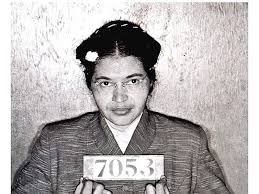In the midst of the black/white discrimination of America, a woman said “Enough!” The seat with the `variable status` was a so-called public law that stated that blacks and whites could not sit in the same place. It was unacceptable for black and whites to even sit side-by-side in a period when racism was playing centre stage.
The first four seats in the Montgomery municipal buses belonged to passengers with white skin. Black-skinned people, or 75 percent of the total amount of passengers of the city busses, had separated seats in the rear of the bus. There were also `variable status` in the middle, where the blacks could sit until the seats of the whites were full.
When the seats of the whites were full, or whenever the driver wanted, the blacks had to unload their seats and go towards the back of the bus. If there was no room at the back, they had to stand; if they were standing and there still weren’t enough seats, they had to get off the bus and wait for the next.
Living became increasingly difficult for blacks in the modern(!) world order. And again, if the white passengers were sitting in the front row of the bus, the black passenger entered through the front door, paid the driver for their fare, got off, and re-entered through the back door.
In fact, most black-skinned people complained about it, but they did not dare to oppose it. Until Rosa Parks said enough. With the story of Rosa’s rebellion;
One day, on December 1, 1955, when some white passengers were standing, the driver stood up and walked to the rear, making the black people in the `variable status` seats get up. Next to Rosa Parks, the male passenger sitting by the window also got up. At this stage, Rosa Parks also moved, but to the opposite side of the public order. She sat down on the chair by the window, staring the driver right in the eye.
Everyone was in great shock. Public order was under threat! Blake angrily asked her why she did not get up, to which Rosa’s response was the response of a rebellious woman: Because “I don’t believe that I should get up and give my place to someone else” she said. The driver stopped the bus and called the police, Rosa Parks was arrested.
As she got off the bus, she asked the police why they were punishing her. The police spoke on behalf of the state; the answer was “I don’t know, the law is law and you are a prisoner”. When she was being arrested, Rosa Parks swore that she will never accept this humiliation again and she will not be a passenger of this shame.
The arrest of Rosa Parks did not attract much attention at first. Rosa Parks was released from Montgomery branch on Friday evening, after unionist Edgar Nixon and a friend of Parks paid the $100 bail. On Friday, Nixon informed Jo Ann Robinson, professor of Women’s Political Council and Alabama State University professor. Robinson decided to take action and made 35 thousand flyers on the same night, calling on Montgomery people to boycott the buses.
The Women’s Political Council (WPC) was the first group to support the boycott. On Sunday (December 4th), calls were made to small black churches in the city to boycott the buses. When they inhumane treatment, the black drivers decided to continue the boycott until they were hired and the seats with variable status in the centre were given the status of first come/first serve.
As a result of her court case, Rosa Parks was fined 14 dollars. But until the court decision, a lot had changed and an organized structure has been formed. A group of activists, including Rosa Parks, gathered at the Mt Zion Church to discuss their next steps. They decided to form a union called the Montgomery Improvement Association. Martin Luther King Jr., the 26-year-old preacher of Dexter Avenue Baptist Church was chosen as the leader.
Black people did not take another bus for 381 days. They walked to their schools and jobs. With every private vehicle that they could get hold of, they created their own busses, transporting people to the places they need to get to for the same price as the state bus. Some white housewives also supported with their cars. The state went through tough times and private companies operating municipal vehicles came to the brink of bankruptcy.
Rosa’s fight continued and the result was successful. Even though it is not enough to eradicate the ongoing racism from the minds of people today, it was one of the important steps in the struggle. Black woman Rosa’s rebellion.
At the beginning of December 1956, the Supreme Court of America, in the case of another similar case (Browder v. Gayle), held the busses would no longer be segregated, on the basis that its case law was prohibiting racial discrimination. But there are still people who have been humiliated in other parts of life because of their race, language and colour; and fascism continues, but Rosa’s steps are the first steps of the struggling woman. Now, dozens of women are fighting against racism and fascism.




